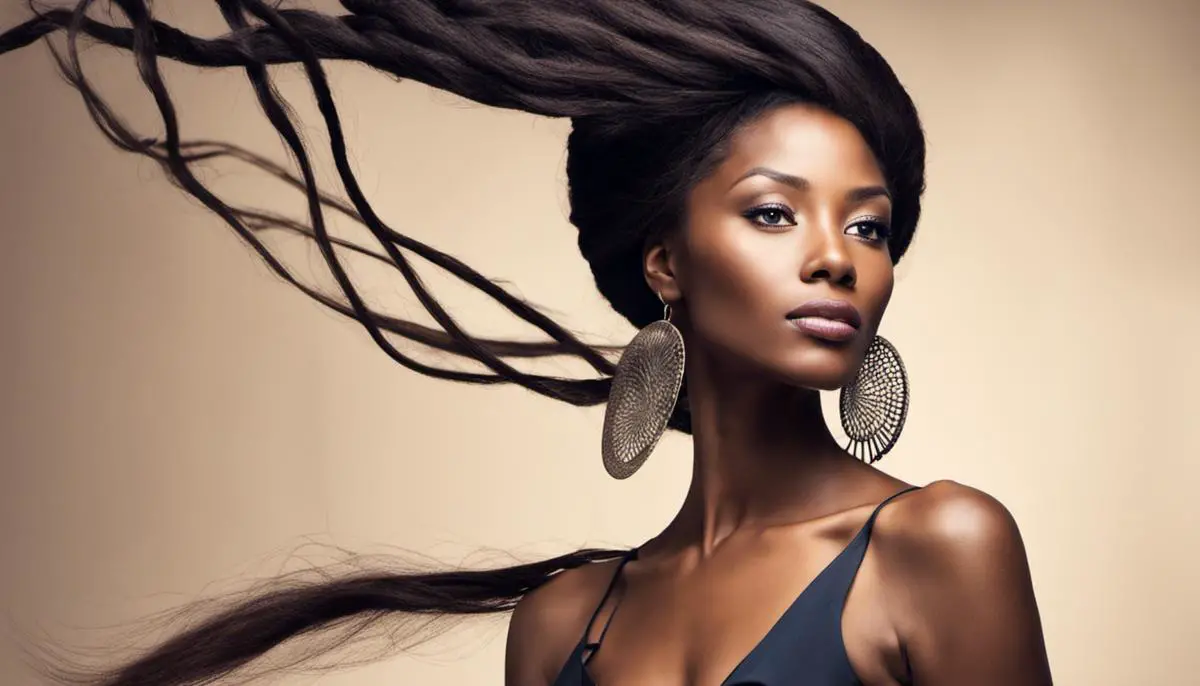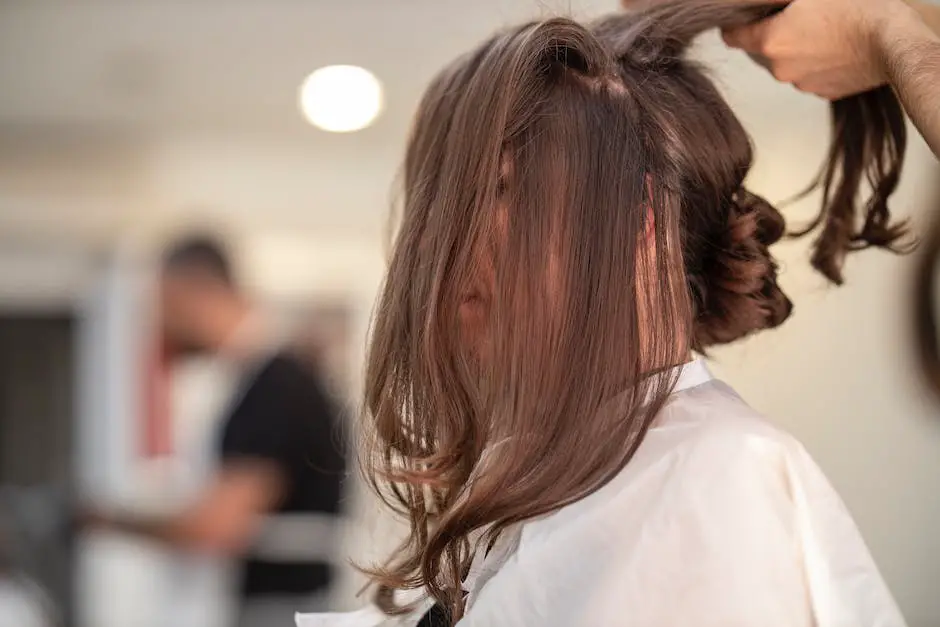African hair, with its beautiful and distinctive textures, requires a unique approach for care and management to showcase its true potential. Appreciating its rich heritage and understanding its diverse structure and properties paves the way for effective strategies in hair upkeep. This composition delves into the fascinating world of African hair types, the selection of natural detangling agents, and techniques for detangling without causing undue harm. Furthermore, it emphasizes the importance of subsequent maintenance to ensure the longevity of detangled, healthy strands. Promising to enlightening your journey towards mastering curative hair routines, we embark on this illuminating voyage into the realm of African hair care.
Understanding African Hair Type
Understanding the Structure of African Hair
African hair has a unique structure compared to other types of hair. Its uniqueness lies in its shape, strength, and growth pattern. Due to its coiled structure, African hair is prone to dryness and breakage. Each hair strand coils at certain points, making it susceptible to snapping at the bends. Additionally, the coiled structure makes it difficult for the hair’s natural oils to travel from the root to the tip, causing the hair to be more prone to dryness.
The growth pattern of African hair also differentiates it from others. It grows in a tight S-shape or Z-shape pattern rather than in a straight line. This unique growth pattern results in what is often described as a cloud of hair. The hair strands grow towards the sides instead of downwards, creating a bushier appearance.
Understanding Specific Types of African Hair
Under the African hair spectrum, there are several hair types – 3A, 3B, 3C, 4A, 4B, and 4C. They differ in terms of curl pattern, thickness, and porosity. The ‘3’ hair types are typically looser curls and waves, while the ‘4’ hair types have a more coiled and kinky texture. Each hair type needs different care techniques for detangling and moisturizing.
Type 3A hair features loose, shiny curls about the size of sidewalk chalk. 3B hair has curl patterns similar to a marker’s circumference. 3C hair, often voluminous, has tightly packed curls resembling a corkscrew.
Type 4A hair has a dense spring-like pattern with the circumference of a crochet needle. 4B features a slightly less defined curl pattern, with the strands bending in sharp angles like the letter ‘Z.’ Type 4C hair is the most fragile type and appears very densely packed. The curl pattern can be so tight that it may not look defined even when wet.
Natural Detangling Techniques
Detangling African hair should be done with care to reduce damage and breakage. Type 4 hair, in particular, requires ample time and patience during the detangling process, usually conducted in sections.
Before detangling, hair should be damp and conditioned with a moisturizing, slip-rich conditioner to smoothen the hair shafts and reduce friction. Using a wide-tooth comb or a detangling brush specifically designed for African hair can be helpful.
Begin detangling from the tip of the hair strand, working gradually towards the root. This method lessens tension and prevents breakage. It’s advisable to use a detangling spray or a homemade mixture of water and aloe vera. Aloe vera conditions the hair and provides ‘slip’ to help the comb glide through.
For extreme tangles, finger detangling can work wonders. The tactile nature of this method helps identify individual knots and gently loosen them. Always remember to detangle gently and take your time to protect your hair from unnecessary damage.
Understanding the unique nature of African hair and its specific types can aid immensely in mastering detangling techniques, promoting healthier and less breakage-prone hair.

Selecting Natural Detangling Agents
Understanding African Hair
To effectively care for and detangle African hair, it is crucial to understand its unique structure and needs. African hair is typically thick, full, and curly, making it more prone to tangling and also tends to be drier due to its coily shape, making sebum, the oil secreted by the scalp, harder to distribute along the hair shaft. As such, African hair requires gentle detangling and ample conditioning to reduce breakage and retain length.
Identifying Natural Detangling Agents
Two effective natural agents for detangling African hair are coconut oil and aloe vera. Both of these substances have properties that aid in moisturizing the hair and easing the detangling process, hence minimizing breakage.
Working With Coconut Oil
Coconut oil is rich in fatty acids that deeply nourish and moisturize the hair. Additionally, it helps improve hair strength due to its high protein content. When applied to hair, it provides a slippery surface that helps the comb glide more smoothly through tangles.
To detangle with coconut oil, start by warming a small quantity of oil until it melts. Part your hair into manageable sections, and apply the oil generously from root to tip. Let the oil sit in your hair for a few minutes to soak in before gently detangling with a wide-tooth comb. Start from the tips of your hair, and gently work your way up to the roots to avoid breakage.
Utilizing Aloe Vera
Aloe vera is packed with vitamins A, C, and E, which contribute to cell turnover, promoting healthy cell growth and shiny hair. Additionally, aloe vera has high water content that helps to hydrate the hair and scalp.
For detangling with aloe vera, you can either use a fresh aloe leaf or buy pure aloe vera gel from the store. If using a fresh leaf, cut it open, and extract the gel. Apply the gel directly to your hair, focusing on tangled areas. Allow the aloe to soak into your hair for a few minutes, then detangle using a wide-tooth comb. As with coconut oil, start at the ends of your hair and work your way toward the roots for the gentlest detangling.
Regular Use and Maintenance
Incorporating either of these natural agents into a regular hair care regime will not only assist in detangling but also add moisture and luster to the hair. The process may be repeated once or twice a week depending on hair needs. Continuous use and proper hair maintenance will result in healthier, more manageable hair.

Techniques for Detangling African Hair
Understanding African Hair Types
African hair comes in varying textures, from wavy to coiled, and typically has a thick, full appearance. Different types of African hair may require slightly different methods of detangling, but all tend to benefit from a gentle, patient approach.
Preventing Breakage While Detangling African Hair
African hair can be particularly prone to breakage. Tangles can cause the hair to break off or become damaged, so it’s crucial to be patient and delicate. When detangling, do not rush or pull harshly. Instead, take your time, working slowly and gently to avoid damaging the hair.
It may be beneficial to use a detangling tool designed specifically for curly or coily hair. Wide-toothed combs or detangling brushes can help to gently remove knots and tangles without causing unnecessary breakage.
Optimal Condition for Detangling African Hair
One of the most effective ways to detangle African hair is to do it when the hair is wet and conditioned. The moisture and slipperiness of the conditioner makes detangling less stressful on the hair strands.
Start by washing your hair with a moisturizing shampoo, then follow with a rich conditioner. Allow the conditioner to sit on your hair for a few minutes to soften the tangles before you start to work through them.
Detangling Methods for African Hair
Begin detangling from the ends and work your way up towards the roots. Trying to comb straight from the top of your head down can push small tangles into bigger knots and cause unnecessary damage or breakage.
Divide hair into sections before beginning the detangling process. Dealing with smaller sections of hair can reduce the potential for re-tangling areas you have already smoothed. Once you’ve detangled one section, you can twist or braid it to keep it separate from the rest of the hair.
For stubborn tangles, consider using a detangling spray or leave-in conditioner to provide additional slip. Furthermore, finger detangling can be especially gentle and allow you to feel and undo particularly problematic knots.
Lastly, once you’ve detangled your hair, ensure it stays hydrated to maintain elasticity and prevent future tangles. Apply a leave-in conditioner or a lightweight oil like coconut or jojoba oil.
Remember, while detangling African hair may seem like a daunting task, with patience, the right tools, and a gentle approach, you can minimize breakage and keep your hair healthy and manageable.

Maintaining Detangled African Hair
Proper Maintenance is Key
Post-detangling, your objective should be to retain the smooth and tangle-free state of your hair. This task involves stepping up your hair care regimen with a focus on moisturizing and protective styling. Moisture is the lifeblood of African hair; it gives it elasticity, shine and prevents breakage. Encourage regular hydration by spritzing your hair daily with a mix of water and natural oils like coconut or olive oil.
Opt for Moisturizing Shampoos and Conditioners
In choosing shampoos and conditioners, opt for sulfate-free products with moisturizing properties. Check ingredients, making sure they contain natural oils like jojoba, argan, almond or shea butter. Deep condition at least once a week, which adds an extra layer of moisture, making your strands less prone to tangling.
Incorporate a Leave-In Conditioner
Adding a leave-in conditioner to your hair care regimen can go a long way to maintain the detangled state of your hair. Applied post-shampoo, leave-in conditioners continue to condition your strands throughout the day, enhancing their manageability and reducing the probability of tangling. They also serve as heat protectants if heat styling is part of your routine.
Protective Styling Works Wonders
Consider protective styles such as braids, twists, cornrows, or buns. These styles limit hair manipulation, reducing the chances of tangling and keeping your ends protected, which is crucial for hair growth and retention. Remember not to pull too tightly to avoid causing tension and possible breakage at the roots. Keep these styles in for a reasonable amount of time to avoid drying and knotting of the hair underneath.
Go Regular with Trims
While it might seem counterproductive, regular trims prevent split ends and single strand knots, which are tangling culprits. Schedule trims every eight to twelve weeks, depending on your hair growth cycle.
Limit Heat Styling
Try to limit the use of heat styling tools as much as possible. These tools dry out the hair and can change the protein structure of your strands, making them more prone to tangling. If you must use heat, ensure you apply heat protectant beforehand and use the lowest temperature setting.
Night Routine is Important
Develop a night routine to maintain tangle-free hair. This routine includes moisturizing your hair and going for protective night-time styles, like loose twists or pineappling. Never forget to sleep on a satin or silk pillowcase or wear a satin or silk scarf to prevent friction that could lead to tangling and breakage.
In conclusion, prioritizing the long-term health and maintenance of your hair requires ongoing daily care and diligence. Along with products and safe practices, patience is a virtue, especially considering African hair tends to grow slower than other hair types.

The quest for maintaining lustrous, detangled African hair is both a science and an art. It requires in-depth knowledge of the hair’s innate properties, the right choice of natural detangling agents, as well as implementing tried-and-true detangling techniques. However, this journey doesn’t end with achieving tangle-free strands. It’s just as critical, if not more, to sustain this state through diligent maintenance routines. Protective hairstyling and regular moisturizing are key aspects of this upkeep. Embracing these well-founded practices guarantees that your hair not only looks its finest, but truly embodies the strength and resilience that African hair signifies.

Leave a Reply